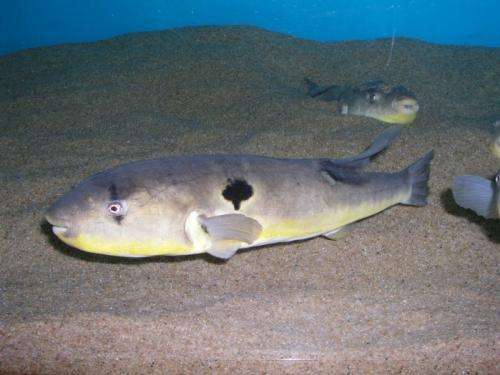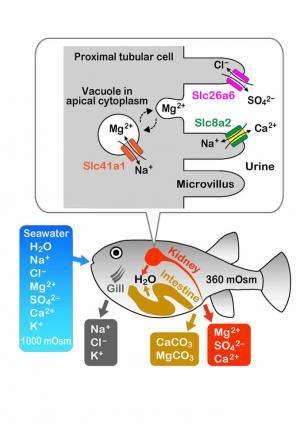How pufferfish meditate magnesium to survive

Scientists at Tokyo Institute of Technology collaborate colleagues at Japan's Shimonoseki Academy of Marine Science and Mayo Clinic College of Medicine, Minnasota, USA, to uncovered the molecular mechanisms behind Mg2+ secretion in fresh and seawater Takifugu pufferfish species.
The bodily functions of creatures that live in aquatic environments are affected by the presence of ions of different elements in the water. Bodies naturally absorb and retain ions as essential nutrients, but an excess of any one ion in the body can be damaging.
The magnesium ion Mg2+ is the second most abundant cation in seawater. Both freshwater and seawater fish maintain a certain level of Mg2+ in the plasma in their bodies, and it has long been known that seawater fish secrete Mg2+ into their urine in order to avoid an excess of absorbed Mg2+ from their surroundings. However, certain species of fish are capable of living in both salt and freshwater conditions, and how they alter Mg2+ secretion in their bodies accordingly is not well understood.
Now, Akira Kato and co-workers at Tokyo Institute of Technology, together with researchers from Japan's Shimonoseki Academy of Marine Science and Mayo Clinic College of Medicine, Minnasota, USA, have uncovered the molecular mechanisms behind Mg2+ secretion in fresh and seawater Takifugu pufferfish species.
"For freshwater fish, Mg2+ is an important nutrient which should be retained if excess Mg2+ is not absorbed from food," explains Kato. "Seawater contains around 30 times more Mg2+ than the blood of seawater fish. If seawater fish cannot excrete excess Mg2+, they face hypermagnesemia which causes failure of normal tissue functions in the nerves, muscles, and heart."

Open genome databases enabled Kato and his team to prepare a list of pufferfish genes that have homology to any known Mg2+ transporting systems in bacteria, plants, and mammals. Through this mammoth task, they pinpointed a gene called Slc41a1 that encodes ion-carrier proteins in other species and bacteria. Gene expression analyses showed that Slc41a1 genes are highly expressed in the duct system of the kidneys in pufferfish.
The team then compared the renal and intestinal expressions of Slc41a1 in seawater pufferfish Takifugu rubripes and the closely related euryhaline pufferfish Takifugu obscurus in both seawater and freshwater environments.
"We discovered that Slc41a1 expression was up-regulated when the fish were moved from freshwater to seawater conditions," explains Kato. Using immunohistochemistry techniques, the researchers proved that Slc41a1 is found in vacuoles (organelles) in the kidney and mediates Mg2+ movement from inside to outside cells. This secretion mechanism allows the excess ions to be flushed from the body in the urine.
"The molecular study of vacuolar Mg2+ secretion in the kidneys of seawater fish has just begun," states Kato. "We need to identify other components that support the function of Mg2+ transporter gene Slc41a1. We also need to confirm if similar systems are generally used by many different organisms, or if this method of secretion has specifically evolved in fish."
More information: Islam, Z. et al. Identification and proximal tubular localization of the Mg2+ transporter, Slc41a1, in a seawater fish. Am J Physiol Regul Integr Comp Physiol 305 (2013). DOI: 10.1152/ajpregu.00507.2012
Provided by Tokyo Institute of Technology



















